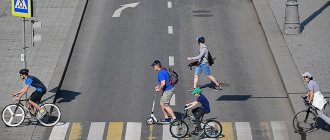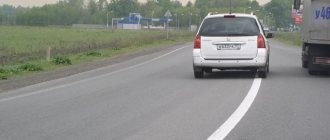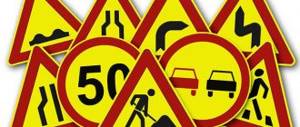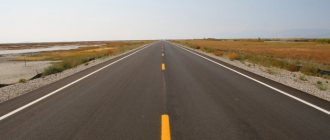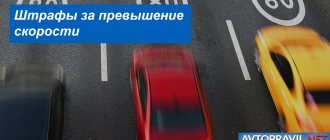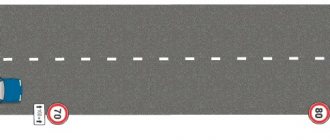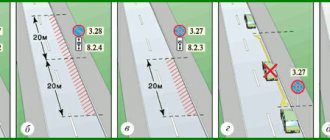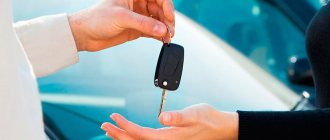○ What is hitting an obstacle?
One of the variants of an accident is a collision with a stationary object that the driver ran into or collided with. Most often, the objects of collision are:
- Bridge supports.
- Roadside pillars.
- Trees growing along the highway.
- Construction materials (sand, crushed stone, bricks, etc.).
- Fencing (for example, about carrying out repair work).
- Buildings and other structures located along the road.
- Doors of another vehicle left ajar.
In terms of the degree of danger, hitting an obstacle can be compared to a head-on collision between two cars, because in both cases injuries and even death are possible. The risk of death for a driver or passenger increases if they are not wearing a seat belt when they collide with an obstacle.
When does criminal liability apply?
Drivers are held criminally liable if, as a result of hitting an obstacle, significant harm to the health of citizens was caused or the accident resulted in death. Such actions of the car owner are provided for in Art. 264 and Art. 266 CC:
- if, after hitting any stationary object, serious negative consequences arise, which include termination of pregnancy, loss of vision or loss of ability to work, then the driver is imprisoned for 2 years;
- if it is revealed that the accident occurred at a time when the driver was intoxicated, then the term of imprisonment is increased to four years;
- if a citizen dies as a result of an accident, then the driver is sentenced to imprisonment for up to 5 years, and if a state of intoxication is detected, this punishment increases to 7 years;
- if two people die as a result of an accident, then the driver will be sent to prison for up to 7 years, and if he commits a collision while intoxicated, he can receive a sentence of up to 9 years.
In addition to a prison term, a ban on the use of a car is imposed for up to three years.
○ Design methods.
Registration of an accident, as in standard cases, can be carried out with the involvement of traffic police officers or without calling them.
✔ With traffic police officers.
The inspector called to the scene collects the following information:
- Driver information.
- Explanations of the participants in the accident.
- Testimony of witnesses.
- Type of accident.
- List of damage received.
Based on the information received, the inspector draws up a list of documents:
- A report of the inspection of the scene of the incident, which indicates information about the road section, characteristics of the roadway, the presence of pedestrian paths and road surfaces. The report also includes information about weather conditions at the time of the accident. The document states:
- Start and end time of the inspection.
- Distances and measurements that will be taken into account in further investigation.
- Actions to record the situation of an accident.
- Statements from participants in the incident.
- Certificate of road accident in the form of Order of the Ministry of Internal Affairs of Russia dated April 1, 2011 No. 154. It contains information about:
- The exact time and date of the incident.
- Participants in the incident.
- Injured.
- License plates of the vehicle.
- Damage to cars.
- Road accident diagram, which describes the circumstances of the accident and explanations of the participants. It states:
- Measuring the position of a vehicle that has hit an object.
- Impact objects.
- Length and direction of braking distance.
- Dimensions of nearby objects.
- Graphic diagram of the collision location with explanations.
- Factors limiting the review.
- Auxiliary guidelines.
- Dimensions of objects perpendicular and parallel to the road line.
- Characteristic points of the vehicle (wheel hubs and/or tow hooks).
- Protocol of inspection and technical condition of the machine - faults are noted, indicating the degree of deformation.
- Protocol for monitoring driver sobriety based on the results of a breathalyzer test.
✔ Without employees.
Registration of an accident without calling the police is possible only if the accident involved 2 vehicles, the drivers of which have no claims against each other and both have a valid MTPL policy. If only one person was involved in the accident, calling an inspector to register the incident is mandatory.
✔ How the Europrotocol is drawn up.
When registering an incident without calling the police, participants independently fill out an accident notification form, which is sent to the insurance company. It is necessary to reflect:
- Circumstances of the accident.
- Scheme of the incident.
- The nature of the damage and its extent.
Despite some advantages of completing the Europrotocol yourself (first of all, saving time), it is still advisable to spend several hours meeting with traffic police officers, because the latter will be able to more competently reflect all the circumstances of the case.
✔ Can I contact the insurance company?
You can and should contact the insurance company with a drawn up European Protocol or an accident notification issued by an inspector. The documents must be submitted to the insurance company no later than 5 days after the incident. But to maximize your chances of receiving compensation, it is advisable to notify the insurance company immediately on the day of the accident.
✔ Who is involved in assessing the damage.
The damage assessment is carried out by an expert from the insurance company that issued your policy. Such a study is necessary in order to calculate the cost of compensation that will be paid to the driver. The examination is carried out at the expense of the insurance company and will be free for the client.
Compensation under CASCO
Even in the event of a collision with a stationary object, and such an event is recognized as an offense, motorists can cover damage to the car resulting from the collision. To do this, you need to apply for CASCO insurance. However, not every case under the contract will involve compensation for damage and insurance payment.
Practice shows that in most cases the owner of a CASCO policy receives compensation for damage that was caused as a result of the road accident in question. Only in exceptional cases under CASCO must a motorist present a certificate of accident, which also simplifies the procedure for receiving money.
applications for insurance payment under CASCO free in word format
Please note! Some circumstances lead to the fact that the insurance company refuses to pay insurance to a person, this happens in the following situations:
- The collision was carried out by a driver who, at the time of driving, was in a state of alcohol or other intoxication,
- At the time of the traffic accident, there was a person driving the car who was not authorized to drive. The ability to drive a car is determined by the presence of a specific person’s name in the insurance policy,
- An insured event, namely a collision with a stationary object, is not provided for in an agreement with the insurance company, which is rare,
- A motorist involved in an accident contacted the insurance company too late to receive benefits.
When contacting an insurance company, you need to carefully study the CASCO agreement, initially not expecting to receive a payment, because insurers are trying in every possible way to avoid obligations to compensate for damage caused during a road accident.
ATTENTION! View the completed sample application for insurance payment under CASCO:
Watch the video. Refusal to pay MTPL and CASCO insurance. What's legal and what's not?
○ In what cases is it necessary to contact the “Emergency Motor Vehicle Commissioner”?
If any problems arise (for example, the insurance company assigns too little compensation), you can make an independent examination and demand compensation in the required amount. To do this, you can contact the emergency commissioner, who can be an individual or legal entity whose services drivers use in case of controversial insurance situations.
Avarcom works only for CASCO users; its services are not available for OSAGO holders. The cost of his services, as a rule, is already included in the policy, so calling him will not incur additional costs.
What is included in a road accident report?
To receive payment under a comprehensive insurance policy, it is important to obtain a certificate from a traffic inspector. Its form is fixed by the Order of the Ministry of Internal Affairs. It includes information:
- about all participants in the accident;
- the time and date of the accident is indicated;
- the numbers of the cars that were involved in the incident are listed;
- information about victims is entered, if any;
- All damage to the vehicle is listed.
This document is often issued with a delay if the accident occurred at night, so you can only receive it in the morning. It is recommended that you notify the insurance company about the accident immediately after the accident.
○ Administrative liability for hitting an obstacle?
The Code of Administrative Offenses does not have a separate article regulating the punishment for hitting an obstacle. Such an offense is classified as failure to comply with traffic rules resulting from a collision. The punishment depends on the reasons that led to the collision. For example, a fine of 1,000 rubles is imposed for the absence of seat belts, and a fine of 500 rubles for using a vehicle in violation of operating rules.
The use by a driver while a vehicle is moving of a telephone that is not equipped with a technical device that allows hands-free negotiations shall entail the imposition of an administrative fine in the amount of one thousand five hundred rubles. (Article 12.36.1 of the Code of Administrative Offenses of the Russian Federation).
Here you need to take into account that the driver will be held accountable if the obstacle that was hit was installed in accordance with all the rules of the law. If there are violations, the owner of the item will be punished.
What does a minor event mean?
Practice also knows cases when, even when hitting a stationary object, a person is not held accountable, since the offense is of minor significance. The criteria for insignificance are determined by the Supreme Court of the Russian Federation by Resolution No. 5 of 2005.
Acts that formally presuppose the establishment of elements of an offense, but due to the nature of the public danger, do not pose a threat and do not harm any social relations, are recognized as minor. Consequently, insignificance is determined by the nature of the act, regardless of whether it is an action or an inaction, which is formally recognized as a violation of the law.
Determination of fault in an accident.
○ Road accidents caused by road services, who is to blame and where to complain?
Failure to comply with requirements for ensuring road safety during the construction, reconstruction, repair and maintenance of roads, railway crossings or other road structures, or failure to take measures to timely eliminate obstacles to traffic, to temporarily restrict or stop the movement of vehicles on certain sections of roads in cases if the use of such areas threatens road safety, entails the imposition of an administrative fine on officials responsible for the condition of roads, railway crossings or other road structures in the amount of twenty thousand to thirty thousand rubles; for legal entities - from two hundred thousand to three hundred thousand rubles. (Clause 1 of Article 12.4 of the Code of Administrative Offenses of the Russian Federation).
If harm to health is caused to a mild or moderate degree, the fine increases to 50-100 thousand rubles for individuals and 400-500 thousand for legal entities.
The guilt of the road services is determined by the traffic police officer, it is recorded in all protocols. Prosecution is carried out through the court.
For example, if construction materials are located in a travel area and are not protected by warning signs, their owner is responsible for the accident. The severity of the punishment depends on the severity of the accident.
Traffic accident while driving in reverse
In the vast majority of cases, parking lot accidents are the result of non-compliance with the rules for driving a vehicle in reverse. Among the reasons for this situation, the following points can be highlighted.
Firstly, when reversing, you need to pay attention to whether it creates obstacles for other cars and whether it poses a threat to drivers. Secondly, were third parties involved (passers-by, other drivers, passengers, etc.) to fully assess the situation when there is poor visibility. Thirdly, was the rule prohibiting reversing in a place designated as a pedestrian crossing in a parking lot, etc., violated?
In the event of an accident in a parking lot, the driver driving backward is considered to be the culprit of the accident, as he is obliged to make sure that there is no interference with other cars. There is no fine for the culprit of a traffic accident driving in reverse.
○ CASCO and hitting an obstacle.
Colliding with a stationary object is usually an insured event under CASCO. Therefore, you can count on compensation in the event of a collision. Most companies provide the possibility of paying compensation for minor damage. But many of them find completely legal ways to avoid transferring funds.
For example, you call your insurance company after an accident and describe the situation. At the other end of the line they assure you that your case is on the insurance list and offer to come for registration. You, happy that you don’t need to collect a bunch of papers, go to the company, write a statement, to which you are told that they will not pay you anything. This is explained by the fact that you left the scene of the accident without waiting for the insurance employee, thereby canceling the possibility of obtaining insurance.
Thus, hitting a stationary object is a type of accident, which has its own characteristics and nuances. Knowing them will help you get compensation after an accident and get out of the situation with minimal losses.
What could be the reasons for the collision?
Practice shows various reasons why drivers hit stationary objects.
These include the following:
- violation of traffic rules, failure to fasten a seat belt, speeding, alcohol intoxication, and so on,
- drinking or drinking while driving, smoking in the car,
- overwork,
- inattention,
- using a mobile phone while driving a car.
There is also such a factor as weather conditions, which not every driver can cope with.
Free consultation with a lawyer regarding an accident.
Detour
Sign 5.16 indicates the stop location of a bus and (or) trolleybus and, in accordance with traffic regulations, does not oblige the bus or trolleybus driver to anything.
You can argue with this, of course, but it’s easy to imagine a bus that is not traveling on the route; is the driver required by traffic rules to stop in all places where sign 5.16 is installed? Of course not. Marking 1.1 does not prohibit stopping or parking.
Stopping is prohibited by clause 12.4 of the traffic rules.
That is, a bus or trolleybus driver is prohibited from stopping at such stops by traffic rules, not by markings. At the same time, the traffic rules do not indicate what to do in case of contradictions between the meaning of road signs and traffic rules.
It is also worth noting that the requirements of clause 12.4 of the traffic rules for a bus or trolleybus driver are mandatory, but sign 5.16 does not oblige the driver to anything according to the text of the traffic rules
Registration of an accident with a traffic police officer
The incident can be registered with or without a traffic police officer. In the first case, the inspector, having arrived at the scene, becomes familiar with the circumstances that led to the violation. At the same time, it collects the following information:
- finds out the driver’s last name, first name, patronymic, as well as his address and telephone number;
- listens to the explanations of the culprit, other participants and eyewitnesses;
- determines the type of traffic accident;
- records all damage received by the car when it collided with an obstacle.
We invite you to read: Hiring during maternity leave
An employee registers an accident by compiling and collecting the following documents:
- Road accident diagram. This is the first document that is recorded at the scene of the incident. It displays precise measurements of the position of the car, objects of impact, the direction of the braking distance, a description of objects located nearby with an indication of their sizes, a graphic image, a description of what limited the driver’s visibility, objects located perpendicular and parallel to the axis of the road with an indication of their sizes, points of the car , namely wheel hubs and tow hooks.
- Explanations of the driver, passengers and eyewitnesses. In them they describe everything that they saw when the accident happened, or did not see and could not see.
- The employee also fills out a certificate, which he issues to drivers, although it may be given with a delay. This document displays information about the time of the incident, participants, license plate numbers, victims and damage to the vehicle.
- Protocol of inspection of the scene of the incident. It must display the area where the collision occurred, indicating the nearest streets. The shape and size of the road are also indicated. The inspector must record, if any, road markings, signs and traffic lights, as well as signs. The protocol should contain information about the pedestrian path, trees, garages, kiosks and other objects nearby. The road surface, holes, bumps and unevenness are described. The protocol should also reflect the weather and visibility conditions at the time of the inspection. It clearly indicates the time of the inspection, all measurements relevant to the investigation of the collision with an obstacle, items seized as evidence, tread prints, recordings from a video recorder or security camera, all statements from participants in the accident and eyewitnesses.
Features of registration of an accident when hitting an obstacle include a mandatory inspection and drawing up a report on the technical condition of the car. It should describe in detail whether there were any malfunctions for which the driver did not have the right to drive the vehicle, since perhaps this was the reason that the collision with an obstacle occurred (hull insurance for an accident of this kind may not be paid in such a case). case).
A sobriety control protocol is also filled out. If necessary, the inspector delivers the driver to the examination site. Then, based on it, the narcologist fills out a report on the driver who hit the obstacle.
Detour is an obstacle
Who is in charge here at the intersection? Test yourself on your knowledge of traffic rules.
Avoiding obstacles is allowed only from the side indicated by the arrow.
The obstacle avoidance direction requires avoiding the obstacle only from the side indicated by the arrow.
| The tractor stops immediately. |
When going around an obstacle, vehicles moving on the free side have the right to move first. So, the tractor driver (Fig. 117, b) must let the bus moving on the free side pass, and only after that continue moving.
The obstacle avoidance direction requires avoiding the obstacle only from the side indicated by the arrow.
Before overtaking or going around an obstacle, the driver gives a signal with a left turn indicator, and when overtaking (bypassing) leaving the occupied lane on the right - with a right turn indicator.
| The tractor stops immediately. |
Special cases of movement: I - oncoming movement on a slope; 6 - oncoming traffic when going around an obstacle.
| Route diagram for road trains. |
For the same turning radius of a road train, semi-trailers have a greater displacement than two-axle trailers, which should also be taken into account when passing, making sharp turns and avoiding obstacles.
| Schemes of cars with swivel wheels. |
Vehicles with all steerable wheels (Fig. 22, b) have significantly greater maneuverability, since their turning radius is reduced by 2 times. In addition, when the wheels are turned parallel, lateral (oblique) movement of the machine is possible, which is convenient when avoiding obstacles.
The commander of a reconnaissance group (flight) prepares scouts to perform assigned tasks, paying special attention to their precise knowledge of their duties. The commander studies with the personnel the route of advance to his facility (the presence of bridges, tunnels, crossings, possible ways to bypass and bypass obstacles), checks whether the personnel know the features of the facility, the location of shelters and shelters, utility distribution centers, and storage facilities on its territory and warehouses
In addition, the commander teaches reconnaissance officers how to properly use radiation and chemical reconnaissance instruments, personal protective equipment, conducts classes on marking the boundaries of contaminated areas, providing first aid to victims, introduces safety measures when operating in contaminated areas and at an object in the affected area, conducting partial and complete sanitization.
When mowing bread, single or double rollers are formed so that the grain mass in the rolls is laid at an angle of 10 - 30 to the direction of movement of the unit. The windrows should be the same in width and thickness, arranged in parallel rows so that the ears do not come into contact with the soil surface. When turning and when going around obstacles, the windrows are placed at least 1-5 m apart from each other. The quality of windrow placement is assessed visually.
| Reproduction of electrocardiograms by an electronic model. monophasic curves of the right and left atria (a and the right and left ventricles (o.v, d, 0 - electrocardiograms B in three standard leads. (According to Akulinich, Babsky, etc. | General view of the device for electronic modeling of electrocardiograms. |
Avoiding an obstacle through a solid line
Since we are talking about a detour, it is necessary to understand the following difference: “detour in the oncoming lane” and “detour in the oncoming lane across a solid line.” In other words, there may be no road markings at the detour site, and if the situation falls under clauses 9.2, 9.3 and 15.3, then the detour around the obstacle will be recognized as a violation and will be subject to sanctions for incorrect detour under Article 12.15 Part 3 of the Administrative Code.
In the paragraphs listed above (9.2, 9.3 and 15.3) there is not a single word about a two-lane road, including one with a 1.1 marking in the middle. Those. avoiding obstacles on a two-lane road through the solid line 1.1 is not prohibited. This detour option is not specified in the Rules. And since there is no direct ban on such a detour, it turns out that it is not prohibited, which means it is allowed. But it's not that simple.
Axial road markings 1.1 are applied on sections of two-lane roads where entering the oncoming lane is prohibited. And despite the fact that there is no direct prohibition on avoiding an obstacle in these conditions, it is recommended to use it in extreme cases when there is no other way to avoid it. Otherwise, sanctions may be imposed for violating road markings (Article 12.16 Part 1 - warning or fine of 500 rubles (figures at the time the article was published)).
In another way (not through the oncoming lane, including along the side of the road and sidewalk) The rules do not prohibit driving around an obstacle, including if the forced detour passes through a solid line dividing passing lanes (there is no other way out anyway), but the object being avoided in this case should be an obstacle. If the object being driven around is NOT an obstacle, then the driver may be charged with a violation of road markings (Article 12.16 Part 1).
Continuing the answer to the question, the sequence in deciding which path to take to avoid an obstacle on a two-lane road can be arranged in the following order: 1 - shoulder; 2 - oncoming lane; 3 – it is advisable not to use the sidewalk at all as a detour route. The sequence is approximate, since it is built in order of increasing possible danger, and the specifics will depend on the real situation.
For example, if there is heavy oncoming traffic on the road, it is advisable to drive around on the side of the road. There is no shoulder, and the sidewalk is separated by a curb - it is advisable to drive around in the oncoming lane while maintaining safety, etc., depending on the situation.
In conclusion, how many words about bypassing a traffic jam or any object (vehicle) that is not an obstacle. A detour “not an obstacle” (including a traffic jam or a traffic jam) will be assessed depending on the detour routes:
- avoiding a traffic jam in the oncoming lane entails deprivation of rights for 4-6 months (Article 12.15 Part 4);
- avoiding a traffic jam on the side of the road - a fine of 1,500 rubles. (Article 12.15 part 1);
- avoiding a traffic jam on bicycle or pedestrian paths or sidewalks in violation of traffic rules - a fine of 2,000 rubles. (Article 12.15 part 2).
For incorrectly avoiding an obstacle (incorrect is one that conflicts with traffic regulations), a fine of 1,000 - 1,500 rubles may be imposed on the driver. (Article 12.15 part 3).
The concept of “hitting an obstacle”
Registration of an accident for different types of accidents has its own nuances. To understand the intricacies of the type we are considering, let’s study its definition. Hitting an obstacle means an incident when a vehicle runs over or hits an object that is stationary. Most often, drivers hit the following objects:
- pillars by the roads;
- building materials;
- bridge supports;
- fencing;
- buildings along the road;
- car doors left ajar.
The danger level of this act is similar to a head-on collision between cars. Death is also possible here. The risk of death for the driver and passengers will increase if they are not wearing seat belts.
Rules for registering an accident without the police in 2020: the subtleties of the European protocol
At the same time, everyone should be aware that according to the European Protocol, the party injured as a result of the collision will receive an insurance payment not exceeding 100,000 rubles; 7) the question of who is at fault for the accident and who is the victim has been resolved peacefully.
2) if people were injured in the accident. In such a situation, the involvement of the traffic police is mandatory.
What should you do after getting into an accident?
2) Install an emergency sign.
Perhaps this, as well as the increase in insurance payments from July 2015, will tip the scales in favor of the European protocol.
Participants in an accident can use the European protocol if the circumstances of the accident are as follows:
- No people were hurt.
- Only the vehicle was damaged (no other material damage was caused).
- The liability of both drivers is insured under MTPL or the international Green Card policy.
- Two vehicles collided.
- The drivers have no disagreement about the damage and circumstances of the accident.
According to the standards of the European protocol, if one of the listed conditions is violated, it is necessary to call the traffic police.
According to Article 1.11 of Federal Law No. 40-FZ of April 25, 2002, there are a number of mandatory conditions for registering an accident under the European protocol:
- There were no injuries, including pedestrians and passengers.
- No more than two vehicles, including vehicles with trailers, are involved in the accident.
Contrary to information spread on the Internet, a car with a trailer in this case is considered as one vehicle.
- Both drivers have valid MTPL policies or a “Green Card” for foreign cars.
- The list of damages, degree of fault and other circumstances of the accident do not cause disagreement.
In addition, the alleged damage must be within the limits on the amount of insurance compensation.
The amount of payments is established by the same law: If you get into a traffic accident, you must stop, turn on the hazard lights and put up a warning triangle.
In addition, you need to remember that compensation under the European protocol has limits. Let’s imagine a situation that satisfies all the conditions for independent registration.
We have a document in front of us that needs to be filled out. Let's first consider the general points about it.
We have already briefly examined the conditions under which a European protocol is issued in case of an accident. Let us highlight their features. You need to understand that any, even minor, errors when filling out can cause refusals under the European protocol from insurance companies.
I say I pay only 1500 and only if you later include this amount in the repair bill.
OK! They took the car, paid, and gave me a piece of paper: 1. Show the car insurance again 3. Do an independent examination 5. File a lawsuit against the person responsible for the accident, since there is no way to get around the 50 thousand limit, even with photos. And this Hemorrhoid will happen, taking into account the fact that my new car was smashed, it was broken quite well, I will have to prove my case and run through the courts, I cannot repair the car until the end of the trial and, accordingly, make full use of it.
